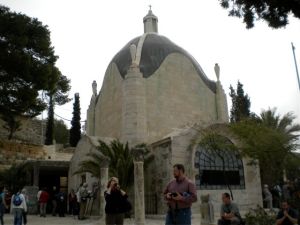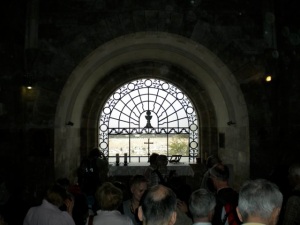 Today’s theme was The Suffering Servant, and we visited churches and places of prayer related to Jesus’ last days, including the Garden of Gethsemane, the Syrian Orthodox Church of St. Mark (a traditional site of the last supper), and the Church of St. Peter in Galicantu (where Jesus was tried by Caiaphas and Peter denied Jesus). The first place we visited was the Church of Dominus Flevit, which is shaped like a tear drop and recalls when Jesus wept over Jerusalem. Gareth Bevan, one of our fellow pilgrims, offered the following reflection.
Today’s theme was The Suffering Servant, and we visited churches and places of prayer related to Jesus’ last days, including the Garden of Gethsemane, the Syrian Orthodox Church of St. Mark (a traditional site of the last supper), and the Church of St. Peter in Galicantu (where Jesus was tried by Caiaphas and Peter denied Jesus). The first place we visited was the Church of Dominus Flevit, which is shaped like a tear drop and recalls when Jesus wept over Jerusalem. Gareth Bevan, one of our fellow pilgrims, offered the following reflection.
By Gareth Bevan
I guess it would be true to say that we have experienced first hand some of the joys and sorrows of this land and its people.
And there are of course the joys and sorrows of our own lives. The joys of new birth, the joys of love and reconciliation. And there are the sorrows which sometimes plunge us into the darkest hours of our very being.
And it such joys and sorrows, the body and mind react in many ways. The body finds its own expression – both inwardly and outwardly. A tear drop is one such expression – as we sometimes weap for joy and indeed weep in our sorrow.
And so we find ourselves outside the beautiful of Dominus Flevit built by Antonio Belutzie, which remembers the spot where Jesus wept over Jerusalem.
In a sense both joy and sorrow meet here. The joyful singing of the disciples and the sorrow of Jesus as he weeps for the future of Jerusalem – prefiguring perhaps Christ’s agony on the cross and the joy of his resurrection. In the words of the hymn, Where’er such joys and sorrows meet and thorns compose so rich a crown.
This beautiful church is shaped like a teardrop, and when we enter we are perhaps for a moment enclosed in a teardrop and, if you like, just for a fragment of our earthly existence we become enveloped in the holy dew of a tear.

But you will notice in the church this is not an introspective. Antonio Belutzie provides us behind the altar with a clear glass and a clear view of Jerusalem. The view is framed but not constrained – and this view compels us to look out as Jesus did in his despair for the future of the city.
But surely our eyes should see more than this – please do spend some time and look – the view perhaps compels us to look beyond Jerusalem, to the world and its injustices, the futility of war, the inequities of oppression and hunger.
As St. Theresa of Avilla puts it: Ours are the eyes through which to look out Christ’s compassion to the world. Surely we are compelled to look at our own countries and their imbalances and also look into our own lives and the way we live them.
Again, St. Theresa of Avilla says: Ours are the feet which he is to go about doing good, ours are the hands with which he is to bless men now.
You know, Jesus still weep; he weeps for those who have lost loved ones through senseless war, he weeps for the people of Haiti and the people of Chile, he weeps with us in our time of desperation, sorrow, and grief – which are sometimes only known to us in our hearts.
He weeps for Jerusalem.
You know, it is love that sums up all the commandments and God never forgets us. In Isaiah 49: I have carved your names in the palms of my hand. And as we close our hands in prayer sometimes in sorrow and in joy God opens his hands and there we will see our names.
So let us pray for Jerusalem, for blessed are the peacemakers; we pray for peace in the world, we pray for peace in our lives and peace at the last. Amen.